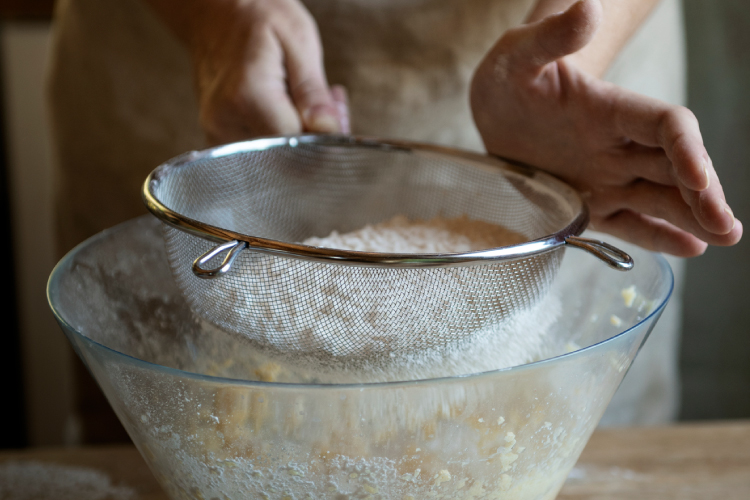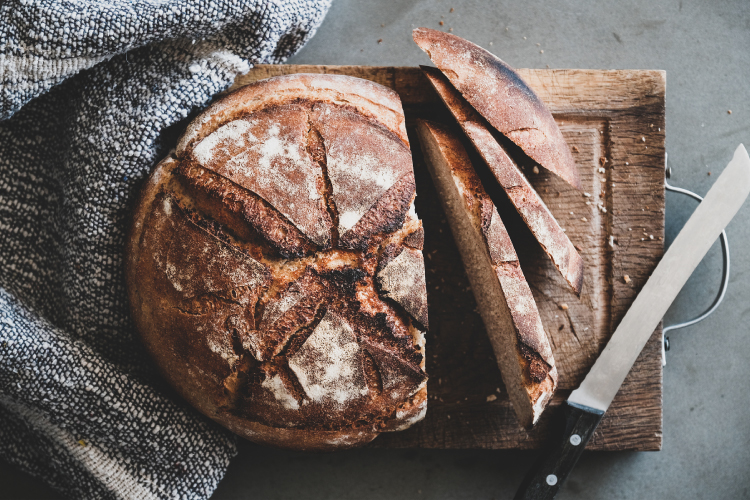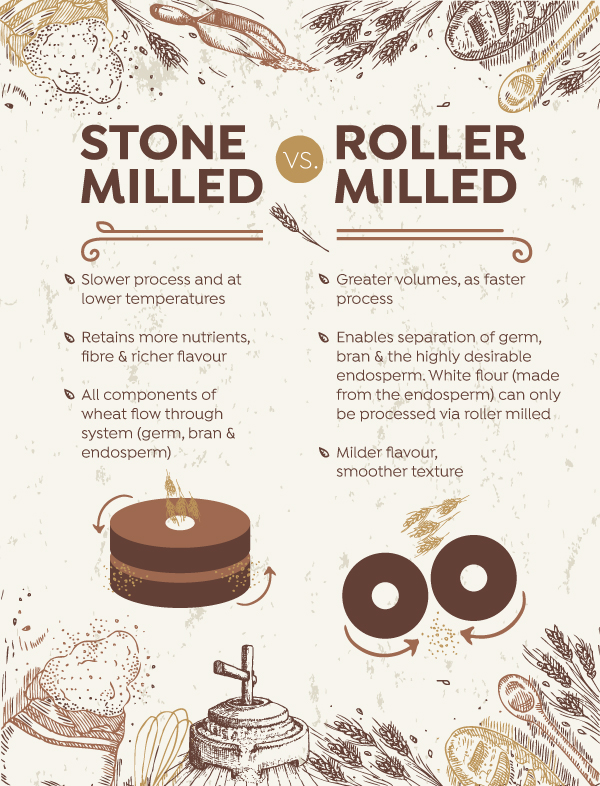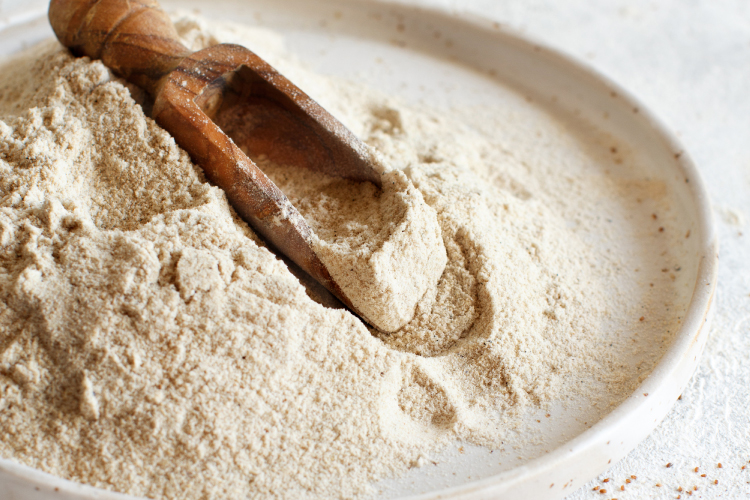What are the different types of flour? Which flour should you use for baking? We’ve compiled the most common flour questions - take a read for the answers below!
WHAT IS THE DIFFERENCE BETWEEN BLEACHED AND UNBLEACHED FLOUR?
Flour is naturally a pale yellow colour when first milled and will lighten with age.
Bleaching flours forcefully speeding up the aging process and creates a soft finer texture and the pure white colour that is commonly associated with flour. However, bleaching is most often done with chemicals and can strip the natural minerals and vitamins that wheat contains.
Unbleached flour will age naturally. It has a slightly darker colour than bleached flour and a slightly denser texture. Unbleached flour takes longer to produce than bleached flour and for this reason is more expensive.
All flours we have in our range are unbleached and chemical free.
WHAT IS THE DIFFERENCE BETWEEN CERTIFIED SUSTAINABLE FLOURS AND CERTIFIED ORGANIC FLOURS?
Sustainable range are certified by ASP, where their other flours are certified organic (ACO).
Certified organic flours are made from grains grown and processed without the use of synthetic chemicals, fertilisers or genetically modified organisms (GMOs). These flours are grown under the strict organic standards and rely on organic principles of farming such as crop rotation, green manuring, composting and use of other natural resources.
Certified sustainable flours are made from grains grown using farming techniques that support soil improvement, use natural inputs and also promote the long-term sustainability of the environment. Australian Sustainable Produce (ASP) flours are tested to ensure that it is residue-free and non-GMO to deliver high quality, nutrient-dense food.
ASP Certified Sustainable products are fully traceable products with no nasties added. All the products are tested to be residue free, GMO free, high quality and nutrient dense. Certified sustainable farmers manage their land in an environmentally friendly way, sequestering carbon, building diversity, enriching the soil and provide an overall nutritionally superior product for you.
Both are good choices!
STORING ORGANIC FLOUR:
Organic flour can last a long time if stored correctly. When you first receive it, put the flour in the freezer for 48 hours to kill any weevil or insect eggs that might be lurking in the package.
Then transfer the flour into a food-grade container (plastic or glass) with a tight lid. This prevents moisture from seeping in and keeps insects and other pests out. It also blocks odours and flavours from other foods or products stored nearby, which could transfer to the flour.

WHY ARE ONLY SOME FLOURS FORTIFIED?
All bread and baking flours made with wheat require fortification of folic acid and thiamine. The only exception to this rule are organic flours.
All sustainable wheat flours are fortified.
Why?
Folate (vitamin B-9) is important in red blood cell formation and for healthy cell growth and function. It became mandated in 1991, in order to help prevent certain birth defects, including NTDs (neural tube defects). (Fsanz)
Thiamine (vitamin B1) is an essential micronutrient in energy metabolism and cognitive and neurological health. This was mandated by FSANZ in 1991 to minimise the incidence of Wernicke-Korsakoff syndrome, a potentially fatal neurological disorder caused by thiamin deficiency.
WHAT IS SOFT WHEAT?
Soft wheat varieties are low in gluten and have a protein content of less than 9.5%. Soft wheat flours are suitable for biscuits, cakes and pastries where a crumbly texture is needed.
WHAT IS HARD WHEAT?
Hard wheat is a variety of wheat with a protein content of more than 12% and is rich in gluten. This wheat helps create strong and elastic bread doughs.
HOW DO YOU MAKE SELF-RAISING FLOUR?
Easy!
For each cup of flour, whisk together with 1 1/2 teaspoons of baking powder. Make sure to whisk all of these ingredients together well before adding into your baking so that the baking powder is evenly distributed within the flour.
WHICH FLOUR IS BEST FOR BAKING BREAD?
Try to avoid gluten-free flours when baking bread as the gluten is what helps create the chew and structure we love in a loaf.
Plain all-purpose flour will get the job done and is ideal for most sandwich breads, quick breads or loaves.
Want to make a rustic, sourdough or hearth loaf? Look for a flour with high protein content (above 12%), such as Organic Stoneground White Bakers Flour.

WHAT IS THE DIFFERENCE BETWEEN STONEGROUND AND ROLLER MILLED?
Roller milling creates a more refined flour that enables the bran and germ to be separated, leaving the endosperm portion of the kernel. These flours are of consistently high quality, smooth in texture, and have a more subtle flavour.
Stoneground milling allows for the grain to pass through the mill slowly and at cooler temperatures retaining the germ, bran and endosperm of the grain along with its precious essential enzymes and nutrients. It is the retention of the germ that provides a more characteristic “nutty” flavour and aroma of stoneground flours.

WHAT IS THE DIFFERENCE BETWEEN WHOLEMEAL AND WHOLEWHEAT?
Just semantics! Wholewheat is the common spelling in the US whereas Wholemeal is used in the UK.
WHAT IS THE DIFFERENCE BETWEEN WHOLEWHEAT FLOUR AND WHITE FLOUR?
Wholewheat flour contains all three parts of the grain, which gives it a slightly darker colour and makes it more nutritious.
Wheat Flour is made up of ground up wheat grains. Wheat has three parts to it:
- Bran - which is packed with fiber
- Endosperm—the largest part of the seed and made up of mostly starch,
- Germ—the nutrient-rich embryo of the seed
White and whole wheat flour both treat the wheat grain differently.
- White - white flour is made up of only the endosperm portion of the wheat, eliminating many of the grain's nutrients.
- Wholewheat flour includes the bran, endosperm and germ of the wheat grain, which gives it a slightly darker colour, coarser texture and makes it more nutritious.
Storage:
WHITE FLOURS - White flours are best kept in an airtight container, in a cool, dry place away from sunlight. White flour keeps up to one year in the pantry under these ideal conditions. For longer storage, or in a warmer climate, stash the flour in the freezer, where it can last for up to two years. Let the flour come to room temperature before you use it for best results, especially when baking.
WHOLEWHEAT FLOURS - Wholewheat and other specialty flours have higher levels of natural oils that causes them to go rancid quickly at room temperature. For optimal storage Freeze whole grain flour for 48 hours before you transfer it to an airtight container. Then store it in the refrigerator for up to six months or in the freezer for up to a year. Bring to room temperature before baking.
WHAT IS HERITAGE FLOUR
Modern wheat is quite different to from the wheat our ancestors ate. Since the 1960s, wheat has been genetically developed to enhance a high yielding crops.
Wholegrain Milling Heritage wheat are varieties that do not contain the modern Mexican Dwarf gene. These older varieties are not bred in a laboratory and their regional characteristics that target taste, flavour and baking performance opposed to high yields.
The baking results are remarkable with bakers and bread lovers now having access to wheat flour that has a distinctive taste and superior baking properties not found in modern wheat flour.
Why use it?
These modified in grain have made it difficult for some people to digest, but that doesn’t necessarily mean they need to change to a gluten-free diet. If you’ve experienced negative health effects as the result of gluten intolerance, but miss your morning toast or favorite dessert, heritage flours may help. These flours also aren’t just for those who experience problems with gluten. Heritage Wheat is used by many because of its taste, results in delicious pastries, breads, pasta and pizza.
WHAT FLOURS HAVE THE HIGHEST PROTEIN AND WHY DOES THIS MATTER?
Bakers flour is also known as bread flour and has a high protein content of more than 12%. The higher protein content means the more gluten that will be formed. This gives bread a firmer consistency, gives the bread it’s chewiness and helps the loaf hold its shape.
“Hard wheat”- variety of wheat with a protein content of more than 12% and is rich in gluten. This wheat helps create strong and elastic bread doughs.
"Soft Wheat”- low in gluten and have protein content of less than 9.5%. These are ideal for biscuits, cakes and pastries where a crumbly texture is needed.
WHAT FLOURS HAVE THE HIGHEST FIBER CONTENT?
Generally, wholewheat flours have higher fibre content due the processing. Below are 5 flours with highest fibre:
Wheat Flours:
- Khorasan Flour (11g/100g)
- Whole Rye Flour (10.6g/100g)
- Wholewheat Bakers Flour (10.6g/100g)
- Wholewheat Heritage Flour (10.5g/100g)
- Whole Spelt Flour (10g/100g)
DIFFERENCE BETWEEN FLOUR AND STARCH
Starch is a simple carbohydrate and flour is made by grinding raw grains.
Flour contains high levels of starch but starch does not contain any flour.
Starch is generally used as a thickening agent, (it has twice the thickening capacity as flour).
DIFFERENCE BETWEEN WHITE FLOURS
Bakers: also known as bread flour, this flour has higher protein levels to produce more gluten and thus a firmer consistency helping the baked good (generally bread) hold its shape.
Plain: also known as all purpose flour, it has a slightly lower protein content which provides a more fluffy or less dense goods such as muffins, cakes and biscuits
Heritage: A different veriety of wheat. This grain was bred and grown before the 1960's
HOW DO YOU CREATE A SOURDOUGH STARTER?
Check out our easy step-by-step guide to making a sourdough starter from scratch.

WHAT TYPE OF FLOUR IS BEST?
Head to our quick guide to flours types and uses to learn which flour is best for your baking endeavour!






